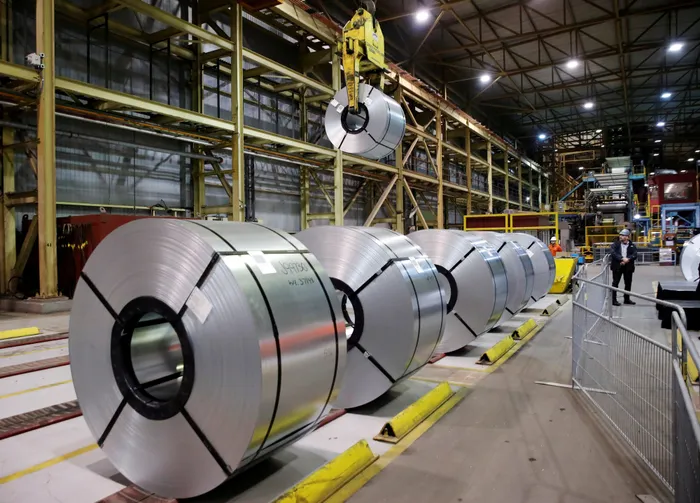A cleaner future for steelmaking in South Africa

For every tonne of steel produced, nearly two tonnes of CO₂ are emitted with estimates for South Africa emitting 2.5 metric tonnes of CO₂ per ton of crude steel, well above the global average.
Image: File.
Steel is indispensable to modern life, forming the backbone of everything from buildings and vehicles to electronics and household appliances, but the way most of it is made has long been one of the world’s dirtiest industrial processes.
Conventional steel production is extremely energy-intensive and relies heavily on coal-fired blast furnaces that burn coal to extract iron from ore, releasing vast amounts of carbon dioxide and other pollutants.
For every tonne of steel produced, nearly two tonnes of CO₂ are emitted with estimates for South Africa emitting 2.5 metric tonnes of CO₂ per ton of crude steel, well above the global average.
The Organisation for Economic Co-operation and Development (OECD) 2025 report titled Implementing the Framework for Industry’s Net-Zero Transition in South Africa, identifies the steel sector as one of the country’s largest industrial carbon emitters. In short, it proposes that South Africa’s iron and steel industry will need to clean up if the country is to reduce carbon emissions and decarbonise by 2050.
The steel industry, it says, can move from blast furnaces to using scrap steel to making steel with electric furnaces while ensuring the utilised electricity is generated through cleaner and renewable methods. The OECD estimates the country will need between $25 billion and $30 billion in investment by 2050 to cut its greenhouse gas emissions by up to 85%.
It recommends a phased approach to decarbonisation in the steel industry: first improving energy efficiency, then using electric arc furnaces to make steel, and finally, after 2035, deploying green hydrogen energy and carbon capture technologies at scale.
While such a national transformation will take decades, companies like Coega Steels and the so-called mini-mills are already proving what is possible. Using scrap steel from end-of-life cars, construction materials, and appliances, electric steel furnaces avoid the environmental costs of mining new iron ore. Each tonne of recycled steel significantly reduces carbon emissions, waste, and energy use.
The move towards green steel is a global one.
For example, traditionally, China relied almost entirely on blast furnaces that used iron ore and coal to produce steel. Over the past decade, however, the country has been steadily expanding its use of Electric Furnaces, which melt scrap steel using electricity rather than coal. In 2015, electric furnaces accounted for only about 6–10% of China’s total steel output, but by 2024 that share had risen to roughly 15–20%. The Chinese government now aims to increase this to 30% or more by 2030. This shift is driven by climate targets, cost efficiency, and the growing availability of scrap steel as China’s economy matures and generates more recyclable material.
A move towards using electric steel production, however, places a burden on governments to ensure there is a sufficient source of scrap steel for electric steel producers to use in their domestic markets amidst high global demand. If South Africa is to move towards green steel, the government needs to continue to ensure scrap steel remains in the country.
Systems such as the price preference system (PPS), that ensures scrap is sold locally before export, and the scrap export tax that incentivises the availability of scrap are essential to keep mini mills accessing raw material.
Mini mills are essential as they are not only greener, but they also create jobs, employing more than 6,000 people across the country, representing a pathway to low-carbon industrial growth.
Coega Steels is committed to greener steel manufacture. It was the first local producer to conduct an Environmental Product Declaration, a study that looks at emissions at every stage of the steelmaking process. It found that 74% of its emissions come from Eskom’s coal-based electricity.
The company aims to cut total emissions by 20% through renewable energy projects and by sourcing clean power from independent producers in line with suggestions from the OECD about improving renewable electricity supply.
Unlike competitors that are lobbying for negotiated pricing agreements for cheaper electricity tariffs, shifting costs onto households and small businesses, Coega Steels is investing directly in renewables. It already operates 785 kW of rooftop solar, will add another 7 MW this year, and has a 16 MW solar plant planned by the end of 2026. This will bring its total renewable generation to 24 MW, easing pressure on the grid while reducing costs and emissions.
Coega Steels and South Africa’s mini mills already represent the first wave of industrial decarbonisation, producing steel far more cleanly than traditional blast furnaces.
With the right policy support, sufficient scrap availability, and a growing renewable power base, South Africa can position itself as a competitive producer of green steel, a win for the environment, jobs, and industrial renewal.
Amit Saini, spokesperson for Coega Steels.
BUSINESS REPORT